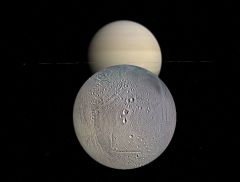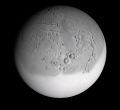Difference between revisions of "Enceladus"
Jump to navigation
Jump to search
(Added gallery.) |
(Added tables, content.) |
||
| Line 1: | Line 1: | ||
| − | Enceladus is a | + | {| cellpadding="2" cellspacing="0" style="margin:25px 0 0 10px; border:3px solid lightsteelblue;width:250px; font-size:90%; font-family:'Arial','Helvetica'; float: right; clear: right;"Template in Orbiter" |
| + | !bgcolor="lightsteelblue" colspan="2" align="center" |Enceladus | ||
| + | |- | ||
| + | |colspan="2" align="center"|[[Image:EnceladusOrbiter2016.jpg|240px]] | ||
| + | |- | ||
| + | |colspan="2" align="center"|'''Enceladus in Orbiter 2016 with D3D9 client with Saturn in the background''' | ||
| + | |- | ||
| + | !bgcolor="lightsteelblue" colspan="2"|Designation | ||
| + | |- | ||
| + | |Name||align="right"|Enceladus | ||
| + | |- | ||
| + | |width="30%"|Reference body||align="right" width="30%"|[[Saturn]] | ||
| + | |- | ||
| + | !bgcolor="lightsteelblue" colspan="2"|Planetary mean orbits | ||
| + | |- | ||
| + | |width="30%"|Epoch||align="right" width="50%"|1999.0 | ||
| + | |- | ||
| + | |width="30%"|Semimajor axis (a)||align="right" width="50%"|2.38×10<sup>8</sup> m | ||
| + | |- | ||
| + | |width="30%"|Eccentricity (e)||align="right" width="30%"|0.0001 | ||
| + | |- | ||
| + | |width="30%"|Inclination (i)||align="right" width="30%"|0.009998° <br> (1.745×10<sup>-4</sup> radian) | ||
| + | |- | ||
| + | |width="30%"|Longitude of the ascending node (LAN, ☊)||align="right" width="30%"|137.0515046° <br> (2.392 radian) | ||
| + | |- | ||
| + | |width="30%"|Longitude of periapsis (ϖ)||align="right" width="30%"|111.7840658° <br> (1.951 radian) | ||
| + | |- | ||
| + | |width="30%"|Mean longitude (L)||align="right" width="30%"|273.8165303° <br> (4.779 radian) | ||
| + | |- | ||
| + | !bgcolor="lightsteelblue" colspan="2"|Selected physical parameters | ||
| + | |- | ||
| + | |width="30%"|Mean radius||align="right" width="30%"|249000 km | ||
| + | |- | ||
| + | |width="30%"|Mass||align="right" width="30%"|7.30×10<sup>19</sup> kg | ||
| + | |- | ||
| + | !bgcolor="lightsteelblue" colspan="2"|Rotation elements | ||
| + | |- | ||
| + | |width="30%"|SidRotPeriod||align="right" width="30%"|118454 seconds (32.9 hours) | ||
| + | |- | ||
| + | |width="30%"|SidRotOffset||align="right" width="30%"|0 | ||
| + | |- | ||
| + | |width="30%"|Obliqutiy||align="right" width="30%"|0.4895 | ||
| + | |- | ||
| + | |width="30%"|LAN||align="right" width="30%"|6.09808 | ||
| + | |- | ||
| + | |width="30%"|Note||align="right" width="30%"|*Elements given are from Enceladus.cfg (Orbiter 2002) | ||
| + | |} | ||
| + | |||
| + | Enceladus is sixth largest moon of [[Saturn]], and the nineteenth largest moon in the [[Solar System]], about 500 km diameter, about a tenth the diameter of [[Titan]]. It was discovered by [[w:William Herschel|William Herschel]] on 28 August 1789. Enceladus has been imaged by Voyagers 1 and 2 and by the Cassini mission. | ||
| + | |||
| + | ==Enceladus in Orbiter== | ||
| + | Enceladus was introduced by the release of Orbiter 2002. | ||
| + | |||
| + | |||
| + | Orbiter versions and add-ons which include Enceladus. | ||
| + | {|class="wikitable sortable” style="text-align: center" | ||
| + | |colspan="8"|<center>'''Orbiter versions and add-ons which include Enceladus'''</center> | ||
| + | |- | ||
| + | !Add-on!!Source!!Version!!Author!!Type!!Release Date!!Compatibility!!Wiki article | ||
| + | |- | ||
| + | |[https://www.orbiter-forum.com/resources/orbiter-2002.5436/ Orbiter 2002]||O-F Resources||020419||martins||Orbiter Download||19 April 2002||Orbiter 2002|| | ||
| + | |} | ||
| + | |||
<gallery widths-"200" heights="200"> | <gallery widths-"200" heights="200"> | ||
| − | EnceladusOrbiter2002.jpg|Enceladus | + | EnceladusOrbiter2002.jpg|Enceladus |
</gallery> | </gallery> | ||
{{SaturnSat}} | {{SaturnSat}} | ||
| + | {{SolarSystem}} | ||
{{Nsat-Stub}} | {{Nsat-Stub}} | ||
Revision as of 02:51, 31 July 2024
| Enceladus | |
|---|---|

| |
| Enceladus in Orbiter 2016 with D3D9 client with Saturn in the background | |
| Designation | |
| Name | Enceladus |
| Reference body | Saturn |
| Planetary mean orbits | |
| Epoch | 1999.0 |
| Semimajor axis (a) | 2.38×108 m |
| Eccentricity (e) | 0.0001 |
| Inclination (i) | 0.009998° (1.745×10-4 radian) |
| Longitude of the ascending node (LAN, ☊) | 137.0515046° (2.392 radian) |
| Longitude of periapsis (ϖ) | 111.7840658° (1.951 radian) |
| Mean longitude (L) | 273.8165303° (4.779 radian) |
| Selected physical parameters | |
| Mean radius | 249000 km |
| Mass | 7.30×1019 kg |
| Rotation elements | |
| SidRotPeriod | 118454 seconds (32.9 hours) |
| SidRotOffset | 0 |
| Obliqutiy | 0.4895 |
| LAN | 6.09808 |
| Note | *Elements given are from Enceladus.cfg (Orbiter 2002) |
Enceladus is sixth largest moon of Saturn, and the nineteenth largest moon in the Solar System, about 500 km diameter, about a tenth the diameter of Titan. It was discovered by William Herschel on 28 August 1789. Enceladus has been imaged by Voyagers 1 and 2 and by the Cassini mission.
Enceladus in Orbiter
Enceladus was introduced by the release of Orbiter 2002.
Orbiter versions and add-ons which include Enceladus.
| Add-on | Source | Version | Author | Type | Release Date | Compatibility | Wiki article |
|---|---|---|---|---|---|---|---|
| Orbiter 2002 | O-F Resources | 020419 | martins | Orbiter Download | 19 April 2002 | Orbiter 2002 | |
| edit The Solar System | |
|---|---|
| Central star |
Sun (Sol) |
| Planets |
Mercury - Venus - Earth - Mars - Jupiter - Saturn - Uranus - Neptune |
| Natural satellites |
Moon - Phobos - Deimos - Io - Europa - Ganymede - Titan - more... |
| Add-ons |
Planets - Dwarf Planets - Small objects - Natural satellites - Alternative star systems |
 | This natural satellite related article is a stub. You can help Orbiterwiki by expanding it. |
